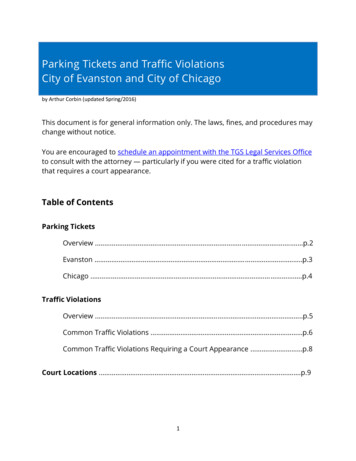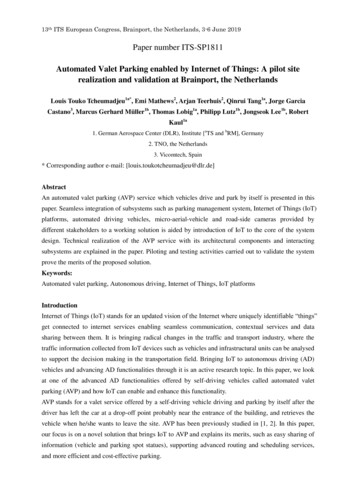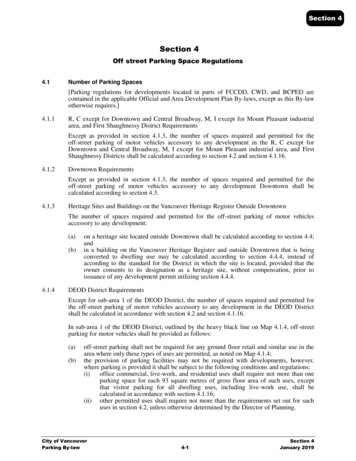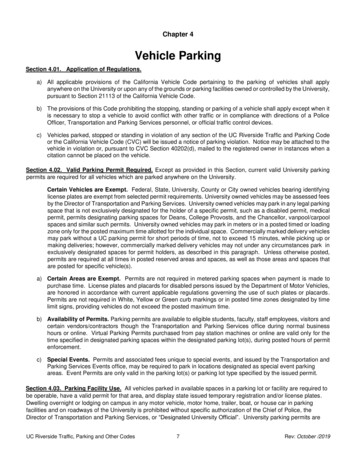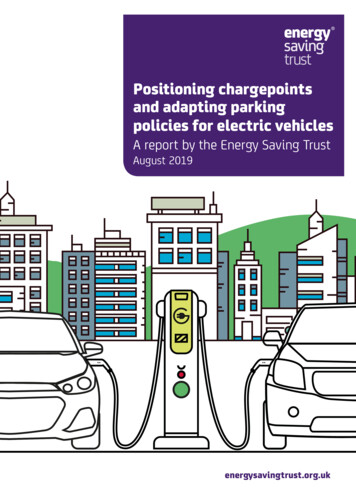
Transcription
Positioning chargepointsand adapting parkingpolicies for electric vehiclesA report by the Energy Saving TrustAugust 2019energysavingtrust.org.uk
Energy Saving TrustResearch reportThis guide is part of a series for local authorities on delivering anelectric vehicle charging infrastructure network.AbstractElectric vehicle (EV) chargepoints need to be positioned carefully, whether on-street or off-street,to ensure ease of use and minimise the impact on pedestrians and street character. It is alsoimportant that appropriate parking restrictions are set and enforced. In addition, localauthorities can use parking policies to incentivise a switch to EVs.This guide covers: off-street EV parking bay layouts which maximise flexibility and potential revenue considerations when placing on-street chargepoints signage and setting Traffic Orders for EV bays parking incentives for EV owners case studies.AcknowledgmentsFunding for the development of this guidance was provided by the UK Government’s Office forLow Emission Vehicles.The Energy Saving Trust would like to thank the following organisations for sharing theirexperiences and assisting with the development of this guidance: Bournemouth BoroughCouncil, Bristol City Council, Cambridge City Council, Coventry City Council, Hampshire CountyCouncil, Local Government Association, London Councils, Nottingham City Council, Oxford CityCouncil, Transport for Greater Manchester, Transport for London, Southampton City Council,Stirling Council, Alfen, Chargemaster, City EV, Ensto, and Vattenfall. .About the Energy Saving TrustThe Energy Saving Trust is the UK’s leading impartial organisation helping people save energy,reduce carbon emissions and use water more sustainably. We do this by directly supportingconsumers to take action, helping local authorities and communities to save energy, usingour expert insight and knowledge, providing quality assurance for goods and services and byworking in collaboration with national and international governments and organisations.2 Energy Saving Trust 2019
Contents1.Introduction. 42.Off-street EV parking bay layouts. 53.Street furniture pressures for on-street chargepoints. 73.1 Major considerations.73.2 Alternatives: kerb build out and lamppost chargepoints.74.Implementing changes to parking and enforcing EV bays. 84.1 Correct signage for EV bays.84.2 Traffic Orders.84.3 Enforcing EV parking measures.104.4 Impact of EV bays on parking revenue.105.Case study – Go Ultra Low Oxford & OxPops. 116.Case study – Cambridge City Council.127.Parking incentives for electric vehicles.137.1 Case study – Isle of Wight.137.2 Case study – Hackney Council.137.3 Case study – Southampton City Council.138.Further resources.149.Support from the Energy Saving Trust for local authorities.15 Energy Saving Trust 20193
Energy Saving TrustResearch report1. IntroductionAccess to public charging infrastructure is a majorconsideration for many people when switching toelectric vehicles (EVs) and is vital where drivers donot have off-street parking.The location of chargepoints has a strong influence onhow often and how easily they are used by residents,businesses and visitors and therefore how muchrevenue – or negative feedback – they generate. Asnew street furniture, on-street chargepoints need tobe positioned carefully to avoid negatively impactingpedestrians and to be accepted by communities,especially where there are already parking andpavement pressures.This guide offers advice for local authorities and othersinstalling public chargepoints on how to overcomethese challenges when positioning chargepoints,illustrated by case studies.Furthermore, the availability, cost and convenienceof parking significantly influences driver behaviour.Changes, such as introducing free or discounted EVparking, can therefore be proactively used by localauthorities to directly encourage or reward a switchto electric vehicles. Such measures can effectivelyinfluence choices and are relatively low cost.4 Energy Saving Trust 2019
2. Off-street EV parkingbay layoutsThe layout of the parking bays in a car parkshould maximise the ease of the use of thechargepoint. Firstly, chargepoints shouldnever be placed in such a way that forcesdrivers to park on the pavement or acrossspaces for cables to reach the chargepointfrom the vehicle. The EV Association Scotlandand OREF’s ‘A Design Guide’1 has numerousphotos of badly sited chargepoints.Secondly, chargepoints should be placed sothey can serve as many vehicles as possible.While vehicles should leave once they arecharged, user experience and access to thechargepoint will be improved if the layout isdesigned to be as flexible as possible. Thishelps to overcome issues associated withcharged vehicles or petrol or diesel vehiclesblocking dedicated EV spaces. This can makethe chargepoint unusable for others if thecharging cables cannot reach other spaces.In general, EVs can use chargepoints withinfive meters as most charging cables areroughly 4-8 metres long.Figure 1 illustrates the impact of differentlayouts. Where vehicles park in baysperpendicular to a pavement or wall, and thechargepoints is installed at the end of therow (to the right in this diagram), this wouldenable a maximum of two cars to charge,depending on the number of sockets. However,Figure 1 illustrates how up to five cars couldaccess a chargepoint, in sequence, if it wasplaced in the centre of a row of spaces. This isinherently more flexible for drivers even if onlytwo spaces are dedicated for EVs only.Figure 1 – How the placing of chargepoints and dedicated EV bays canrestrict or maximise access. Not to scale.21 Orkney Renewable Energy Associationand Electric Vehicle Association ofScotland, 2016, Electric Vehicle ChargingInfrastructure, A Design Guide, 1.3.3.pdf2 Adapted from the UK EVSE ProcurementGuide (p21) and Orkney RenewableEnergy Association and EV Association ofScotland, A Design Guide (p9). Energy Saving Trust 20195
Energy Saving TrustResearch reportIn car parks where vehicles park nose-tonose, chargepoints can be placed so they canserve any two of up to eight bays, as shownin Figure 2. Again, placing the chargepoint inthe centre of a row maximises its accessibilityand practicality. The chargepoints should beprotected from damage by a crash barrier.Figure 2 – How the placing of chargepoints and EV bays can restrict ormaximise access in an car park island bay layout. Not to scale.3Figure 3 – A rapid chargepoint well-positioned within a car parkPhoto credit: Nottingham City Council.3 Adapted from the UK EVSE ProcurementGuide (p21) and Orkney RenewableEnergy Association and EV Association ofScotland, A Design Guide (p9).6 Energy Saving Trust 2019
3. Street furniture pressuresfor on-street chargepointsInstalling a chargepoint on a pavementtakes up valuable space so it is importantto assess potential locations carefully. Ifa chargepoint excessively narrows thepavement, it will cause an obstructionimpacting pedestrians, wheelchair users,people with pushchairsor those with a visual impairment.Poorly-sited charging infrastructure is likelyto lead to negative feedback from residentsand campaign groups4 and once in the ground,chargepoints are very difficult and expensiveto move.Some local authorities are starting to developguidance to specifically manage chargepointson pavements. For example, the draft revisedNew London Plan5 (p282, paragraph 10.6.8)states that: physical infrastructure shouldideally be located off the footpath. Wherecharging points are located on the footpath,the pavement must remain accessible toall users, including disabled people. Furtherguidance for local authorities is expected tobe published in 2019 by Transport for London.3.1 Major considerationsFor a wheelchair user and a pedestrian to passside-by-side, a clear footway width of 1.5m isrequired6, although recommendations vary.To avoid creating a tripping hazard,chargepoints should not be placed at the backof a pavement or wall-mounted where thisrequires cables to stretch across a pavement.4 For example, Living Streets, Pavementsfor People, accessed 2019 ampaigns/pavements-for-people5 Greater London Authority, 2018, The DraftLondon Plan t london plan showing minor suggested changesjuly 2018.pdf6 HM Government, Inclusive MobilityGuidelines t/uploads/system/uploads/attachment data/file/3695/inclusive-mobility.pdfAvoid installing chargepoints in locationswhere the available pavement space hasalready been restricted by other streetfurniture, such as road signs, feeder pillars,and bike racks.3.2 Alternatives: kerb build outand lamppost chargepointsWhere chargepoints are installed onstreet, one solution to avoid reducing spacefor pedestrians is to place the charginginfrastructure on a ‘kerb build out’ (or ‘plinth’)between the vehicles in the roadway, protectedby barriers. This approach reduces the numberof parking spaces available but some feelthis approach is more compatible with widerinitiatives to reduce car use and encourageactive travel.Another increasingly popular solution amonglocal authorities are lamppost chargepoints inresidential areas. These integrate a chargepointsocket into the lamppost, removing the needfor additional street furniture, a new DNOconnection or upgrade, planning permissionor street works. They are faster and cheaper toinstall than free-standing column chargers andvisually less obtrusive.Early issues around unmetered electricitysupply now resolved with Ofgem7 but thesechargepoints are only suitable for slowcharging. Some designs are very minimalist,such as Ubitricity’s Simple Sockets, but theserequire EV users to have a special SmartCablein order to meter the electricity supplied andcomplete payment8. In contrast, CityEV’sproducts integrates these functions withinthe charging unit9 and more solutions arebecoming available on the UK market (seeFigure 4).It should be noted that some local authoritieshave initiatives to move lampposts to the backof pavements to improve accessibility, but thismakes them less suitable for retrofitting withchargepoints (unless a ‘satellite post’ is used,which would add extra street furniture).Figure 4 – Lamppost chargepoints of different designs7 Elexon, 2017, SVG201/03 – ElectricVehicle Charging Where the ApparatusContains a Meter 0/06SVG201 03 EV charging v1.0.pdf8 Ubitricity, The MobileCharging system,A new perspective on electric mobility,accessed 2019 m-2/9 CityEV, Public Authority Charge Points,accessed 2019 oto credit: CityEV Energy Saving Trust 20197
Energy Saving TrustResearch report4. Implementing changes toparking and enforcing EV baysTo make a new chargepoint accessible andfunctional, changes to parking restrictionsare likely to be required. There are severalpracticalities and choices to consider whenimplementing dedicated EV bays includingsignage, setting appropriate Traffic RegulationOrders (TROs) and assessing the implicationsfor parking revenue generation.4.1 Correct signage for EV baysClear signage and painted bays help EV driversfind chargepoints, understand any restrictionsand should prevent them from being blockedby petrol or diesel vehicles. Signage in councilowned locations or locations managed bythe Highways Agency must comply withDepartment for Transport (DfT) Guidelinesshown in Figure 5. For links to the DfT workingdrawing, see Further Resources.4.2 Traffic OrdersFigure 5 – DfT approvedP660x9 standard signagefor EV charging baysTraffic Regulation Orders (TROs), or TrafficManagement Orders (TMOs) in London, arethe main mechanism for implementingchanges to parking measures, whetheron-street or in public car parks. TROs allowlocal authorities to regulate, restrict orprohibit the use of a road, or any part ofa road, by vehicular traffic or pedestrians10.TROs are enforced through Penalty ChargeNotices (PCNs).In the context of EVs, TROs can be used torestrict access for petrol or diesel vehiclesto charging bays and limit the length of stayof an EV, ensuring customer turn-over ata chargepoint.Challenges can be encountered when decidingwhich type of TRO is best, experimental orpermanent, and in setting the limit on lengthof stay.4.2.1 Permanent and Experimental TROs10 LowCVP, 2015, Local Measures toencourage the uptake of low emissionvehicles, p46 1 Full details at iefing/Summary/SN06013To establish a permanent TRO, a public noticemust be placed and publicised adequately(e.g. in a local newspaper or online) andnotices may be displayed in the relevantarea. Anyone may object in writing (within21 days of the notice being given) and it isthen discussed by an internal committeeand approved by senior management andelected members11.12 Gloucestershire County Council,accessed 2019, Explanation ofExperimental Traffic Orders aination of experimental trafficorders-36785.pdf8 Energy Saving Trust 2019In contrast, experimental TROs only stay inforce for up to 18 months while the impactsare monitored but changes can be made toany restrictions (except charging) within thefirst six months. It is not possible to lodge aformal complaint to an experimental TROsuntil it is in force, and then only to it beingmade permanent12. Experimental TROs cantherefore offer a more flexible approachthan permanent TROs by allowing minorchanges without the need for another publicconsultation.Local authority officers consulted by EST hadmixed opinions on the best approach withregard to EV parking bays. The advantages,disadvantages and key characteristics aresummarised in tables on the next page.4.2.2 Setting a length of stay limit foran EV bayTROs can be used to control the lengthof time a vehicle stays in a location, andtherefore how long an EV can spend pluggedinto a chargepoint. Setting an appropriatelimit is a balance between allowing sufficienttime for recharging while also encouragingcustomer turn-over.In most cases, a fully-charged car cannot beunplugged by another user and representsa major inconvenience for other EV driverswishing to use the chargepoint. Limits areespecially important on rapid chargers, suchas for taxi drivers or at EV charging hubs.Chargepoints in locations such as trainstations or park & rides are exceptions as carsare likely to be left for much longer.A common approach adopted by severallocal authorities is to restrict the lengthof stay during the day in popular locations(e.g. town centres) and assume that mostpeople, likely visitors or commuters, willjust be ‘topping-up’ their car at a publicchargepoint during the day. They are likelyto fully recharge at home as it is often moreconvenient and cheaper if they have access tooff-street parking. Residential areas withoutoff-street parking may need longer limits toallow full recharging during the day, and thenunrestricted overnight.Typical charging times for different types ofchargepoints are shown in the table on thenext page, and can be used as a guide forsetting TROs. The case studies later in theguide also offer examples of TROs.
Table 1: Comparison of regulation ordersPermanent TrafficRegulation OrderExperimental TrafficRegulation OrderDurationPermanentMaximum 18 monthsMinimum publicnotice required21 days7 daysObjectionsObjections can be made beforethe TRO is approvedOnce the ETRO is in place,objections must be made within sixmonths after the it came into effect,or if changes to ETRO are madePublic inquiryRequired if certain objections.42 days’ notice required.Not requiredAbility to makechangesNew TRO needs to be issued,following the same, lengthyprocessWithin first six months of ETROcoming into effectAfter expiryN/AConverted to permanent TRO,or removedAdvantages Permanent Quicker and cheaper toimplement Opportunity for public toexpress views Familiar statutory process Public objections can bebased on the actual effectsof the order, rather thanpreconceptions Can be altered while in force Can be made permanent easily,providing certain conditionsare metDisadvantages Time consuming and costlyto gain approval Potentially subject to publicinquiry Potential to fail Temporary – up to 18 months May need to be revisited to bemade permanent If certain conditions are notmet, the process for permanentTROs may apply on expiryTable 2: Guide to chargepoint infrastructureSlowFastRapidPower rating3-7kW7-22kWOver 43kWElectrical supplytypeACUsually AC, DCavailable athigher ratesAC and/or DCTypical chargetime (N.B. willdepend on thevehicle’s batterysize)4 to 8 hours2 to 4 hours25-40 minutes to reach80% chargeEV compatibilityAllMostMost Energy Saving Trust 20199
Energy Saving TrustResearch report4.3 Enforcing EV parkingmeasures4.4 Impact of EV bays on parkingrevenueCurrently, local authorities are taking differentapproaches in how actively they enforce EVrelated TROs through Penalty Charge Notices(PCNs). As demand for chargepoints grows,and in response to EV drivers’ frustration atblocked chargepoints, it is likely that greaterenforcement will be required.Parking revenues can be seen as a stableincome source for some local authorities andtherefore changes to introduce chargepointswhich result in lower revenues may be resisted.It is common for EV drivers to only pay forusing the chargepoint and not for parking,although this varies between locations.For on-street bays, PCNS can be issued againstconventionally-fuelled vehicles parked in anEV charging bay under PCN contraventioncode 231, under code 14 if it is parked but notrecharging, or code 301 if is parked for longerthan permitted by the TRO13. For off-streetparking, London boroughs and other councilshave amended their enforcement protocols sothey can use PCN contravention code 7114.Options to reduce the impact on parkingrevenues include: installing chargepoints inunder-used car parks or streets; relocating ICEbays wherever possible; creating new parkingspaces for EV bays or; making car club baysdual-purpose17. In Coventry, revenue generatedfrom charging by the council is ring-fencedand a share is reinvested in parking services.Where there is a time-limit and an EV ownerpays for charging but not for parking, thereneeds to be a mechanism to monitor thelength of stay. This could be through regularinspections by civil enforcement officers.Usefully, some chargepoints displays indicatehow long a car has been charging.It is also useful to consider implementinga mechanism to penalise ‘overstaying’, thesituation where an EV is fully charged butremains plugged in, blocking access forothers. This may involve higher fees after aset period, especially on rapid chargepoints,enforced via the chargepoint operator.For example, Geniepoint network has anoverstay fee of 10 for vehicles which remainconnected to their rapid chargepoints for overan hour, and a further 10 is applied for eachsubsequent hour15.To help deter internal combustion engine (ICE)vehicle drivers parking in EV bays, considermaking the bays look different throughdifferent colouring and an EV logo or suitabletext. EV bays can be made to look similarto disabled spaces, for example includinghashed areas, but with a different line colourand clear signage to indicate that they are forEVs only16.13 For example, see City of WestminsterKerbside Management and EnforcementCode of Practice, p46. /kerbside management andenforcement code practice.pdf14 UK EVSE, 2015, Making the rightconnections, p22 e/15 ChargePoint Services GeniepointFAQs, accessed 2019 /#toggle-id-1116 UK EVSE, 2015, Making the rightconnections, p22 e/17 See UK EVSE, 2015, p22, for moreinformation about enforcing car club baysthat are also EV charging bays.10 Energy Saving Trust 2019Depending on the contract with thechargepoint operator, the local authority maybe able to set a tariff rate and connection feeto generate revenue from charging, offsettingthe ICE parking revenue that has been lost.However, tariffs should be affordable fordrivers and the cost of the charging equipment(if not 100% grant funded), operation,maintenance and electricity used may need tobe recouped first. Where chargepoints are inhigh demand, the income from charging couldbe higher than from parking.
5. Case study – Go Ultra LowOxford & OxPopsGo Ultra Low Oxford is a project run byOxford City Council and Oxfordshire CountyCouncil to trial different on-street chargingtechnologies in residential areas for a year.The project was awarded 816,000 by theOffice for Low Emission Vehicles (OLEV) in2016 and, depending on the results of the trial,there will be a city-wide roll-out of up to 100chargepoints by April 2021.Figure 6 – Oxford residents,councillors and council officersat the launch of the chargepointtechnology trialWhile a proportion of Oxford’s population fitthe profile of early adopters, approximately28% of households live in terraced housingand lack off-street parking, presenting abarrier to EV uptake.Five types of chargepoints at 30 locationsare being assessed in the trial for both theirtechnological and practical suitability18: domestic wallbox chargepoint witha pavement cable channel to allowresidents to use their own electricitysupply without causing a trip hazard bystretching a cable across the pavement19 lamppost chargepoints column (free-standing) chargepoint withdifferent features, including a ‘slim-line’version.18 Go Ultra Low Oxford Chargepointtypes, accessed 2019 https://www.goultralowoxford.org/info/5/chargers19 Go Ultra Low Oxford Pavement cablechannel, accessed 2019 – 3/chargers/320 Oxford City Council, accessed 2019,Oxpops - whole street electric vehiclecharging trial https://www.oxford.gov.uk/info/20185/electric vehicles/1288/oxpops - whole street electric vehiclecharging trial21 Oxford City Council, 2018, Nominateyour street for the world’s first ‘pop-up’electric vehicle charging points e your street for the world sfirst pop-up electric vehicle chargingpoints20 Oxford City Council, accessed 2019,Oxpops - whole street electric vehiclecharging trial https://www.oxford.gov.uk/info/20185/electric vehicles/1288/oxpops - whole street electric vehiclecharging trial21 Oxford City Council, 2018, Nominateyour street for the world’s first ‘pop-up’electric vehicle charging points e your street for the world sfirst pop-up electric vehicle chargingpointsAs well as collecting data on usage andreliability, residents (both EV and non-EVdrivers) are participating in interviews andsurveys conducted by the University of Oxfordto better understand users’ experiences andthe impact on streets.Each type of chargepoint technology hasdifferent implications for on-street parking: wallbox and pavement cablechannel: No reserved parking bay asthe chargepoint is used exclusively byone household so a dedicated bay is notacceptable lamppost chargepoint: no reserved EVbays but plan to install the equivalentof 3 sockets per EV driver, so thereshould be some flexibility to access asocket. Partly made possible by the lowerunit cost of a lamppost chargepoint,compared to a column chargepointLessons learnt though the trial will be sharedinitially via a report available exclusivelyto APSE members. In late 2019 or early2020, a final report written by OxfordUniversity Transport Studies Unit will bemade widely available.Additionally, Oxford City Council initiated aseparate trial, Oxpops20, in 2018, funded byan Innovate UK grant and private investment.The project involves installing numerouschargepoints on a street nominated byresidents21 while minimising street clutter(a ‘whole-street approach’). Innovatively,the six UEone on-street chargepointsare ‘retractable’, housed in a column thatdisappears underground when not in use,although there is a small above-groundfeed pillar. There will be no changes toparking bays or restrictions, similar tolamppost chargepoints.Through these trials, Oxford is makingsignificant strides to ensure all its residentscan take advantage of the benefits of electricvehicles in coming years, regardless of wherethey park. With more technologies beingintroduced, the lessons of these trials will be column chargepoint: Dedicated EV bays, invaluable in ensuring the best infrastructureenforced through a TRO. During the day,is chosen for each situation.the EV bays will be available to residentsand visitors for a maximum of 3 hourswhich encourages customer turnover andis in line with nearby non-EV bays. After6pm, the bays will only be for residentpermit holders wanting to charge. Energy Saving Trust 201911
Energy Saving TrustResearch report6. Case study – CambridgeCity CouncilCambridge City Council is encouraging theuptake of electric vehicles, particularly bytaxi and private hire drivers, as part ofcontinuing efforts to reduce air pollutionand carbon emissions in the city22. Differentapproaches have been taken to managingEV chargepoints bays, reflecting user needsand expectations.22 Cambridge City Council, 2018, Newaction plan set to tackle air quality andpollution 3 Significant taxi licencing policy has beenintroduced to ensure this transition. Moreinformation: -and-handbook24 Cambridge City Council, 2018, Taxidrivers urged to consider switchingvehicles as rapid electric charging pointsare launched idelectric-charging-points-are-launchedFour chargepoints, two 3kW and two 7kW,have been installed in two council-operatedmulti-story car parks. A TRO is in force torestrict the bays to EVs and a maximum twohour stay. There is no fee for the electricitybut car parking charges still apply. Four 7kWchargepoints have also been installed at twopark and ride sites. No TRO is required, thereis no maximum stay and connection andelectricity fees apply.Following a successful bid, the council wasawarded 426,000 from the OLEV TaxiScheme to install 18 rapid and three fastchargepoints in and around Cambridge by2020. Match-funding of 100,000 is beingprovided by both the Greater CambridgeFigure 7 – Rapid chargepoints in Cambridge for taxisPartnership and the City Council, and thetransition is supported by stringent taxilicensing requirements and other incentivesto encourage EV uptake23 24.As of May 2019, six rapid chargepoints havebeen installed at three locations, includingcouncil car parks and on-street. In December2018, the four taxi-only rapid chargepointsdelivered 4.5MWh of 100% renewableenergy, enabling 15,571 emission-free milesto be driven and resulting in a carbon savingof 3.75t C02.For the car park locations, the dedicatedcharging bays are painted green and haveclearly signed TROs in place restrictingcharging to EV taxis-only for one hour. For theon-street location, the markings avoid greenpaint as this was deemed to be an on-goingexpense for maintenance by the transportauthority. The TRO is subtly different: it isfor EV permit holders only, to allow futureflexibility for residents. The time restriction isagain a one hour stay. This time limit was feltto be reasonable as the rapid chargepointscan provide an 80% charge in 30 minutes andtaxi drivers are unlikely to want to stay longer.In the car parks, the chargepoints have beenlocated so that two rapid chargers can servefour bays and there is room for expansion.Initially, only the two central bays are marked,but the outer bays will be marked up asdemand grows, a practical compromisebetween facilitating EV charging whilepreserving parking revenue.Where possible, car parks were chosen overon-street locations for the chargepoints.The City Council has previously receivednegative feedback about installations fromreside
2. Off-street EV parking bay layouts The layout of the parking bays in a car park should maximise the ease of the use of the chargepoint. Firstly, chargepoints should never be placed in such a way that forces drivers to park on the pavement or across spaces for cables to reach the chargepoint from the vehicle. The EV Association Scotland





